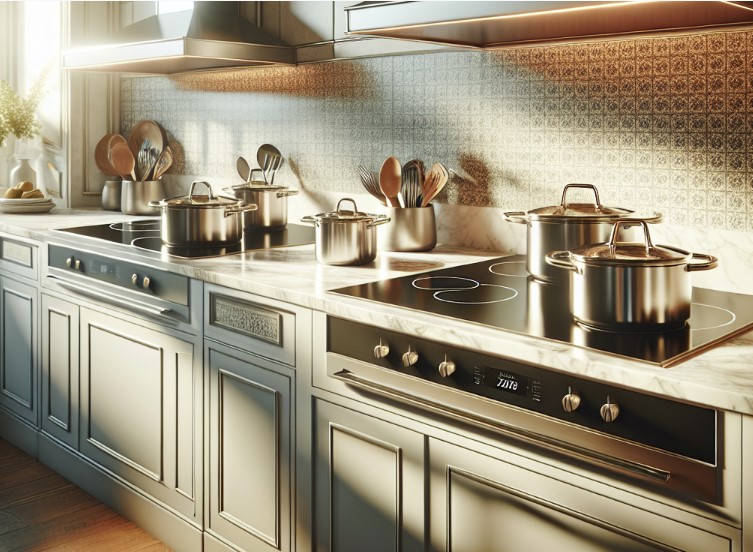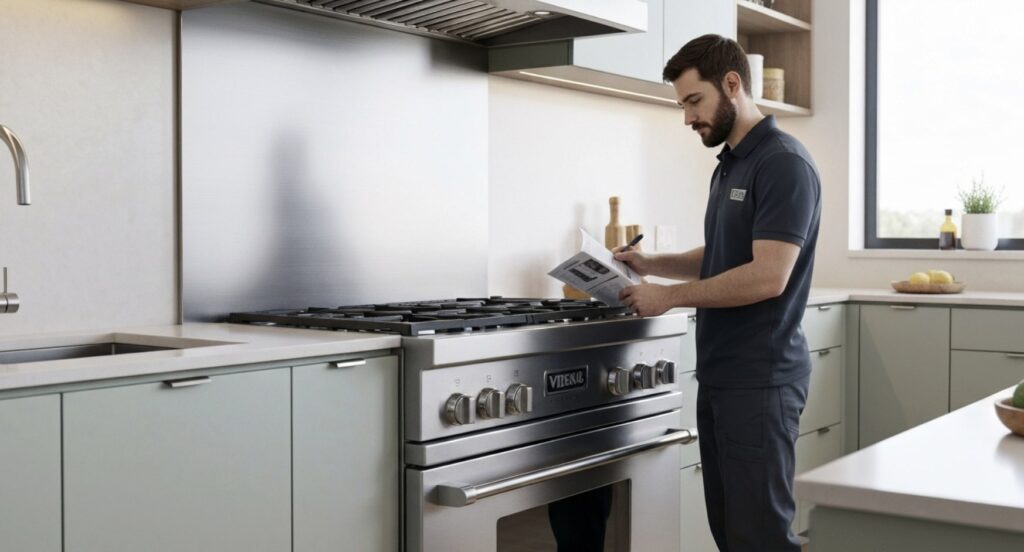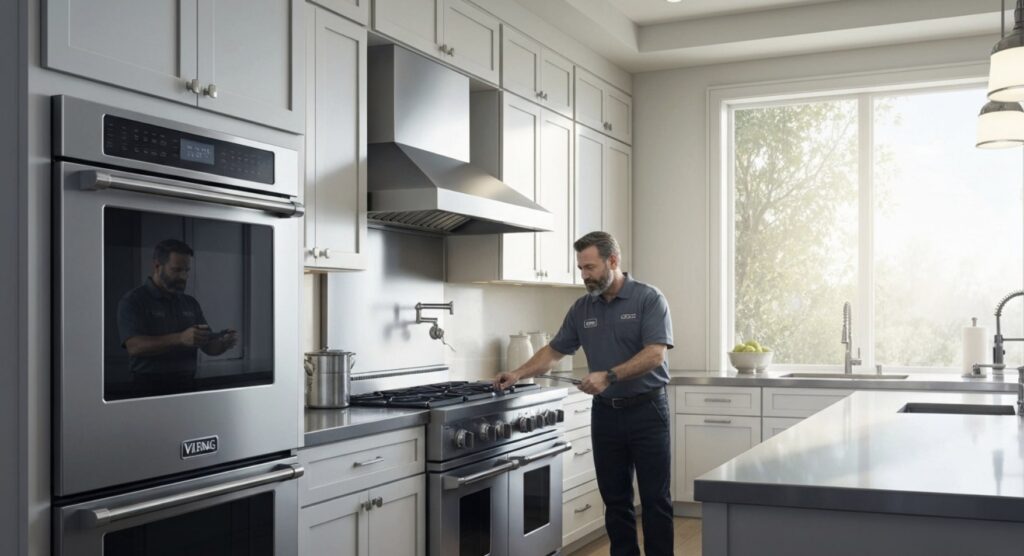When you upgrade your kitchen, picking the right type of cooktop is very important. Gas stoves have been the go-to choice for a long time. But now, induction cooktops and electric cooktops are growing in popularity. This guide will look at the good and bad sides of induction vs. electric cooktops. It will help you choose the best one for your cooking needs and way of life.
Unveiling the Pros and Cons of Induction vs Electric Cooktops
Choosing between an induction cooktop and an electric cooktop can be tricky. There are many advanced features in today’s appliances to consider. Each option has its own benefits and downsides, which can affect your choice. Your budget, cooking style, and kitchen setup are all important when selecting the right one for your home.
1. Overview of Induction Cooktop Benefits
Induction cooktops are known for being quick and energy-saving. The key to this is their electromagnetic technology. Unlike normal electric cooktops that heat the surface, induction cooktops create heat right in the pan.
This method helps food heat up faster and allows for better temperature control, which is great for boiling water or searing meat. In addition, induction cooking is safer and uses less energy.
Since the cooktop doesn’t get hot, the chance of burns is lower, and they waste less heat, leading to lower energy use.
2. Drawbacks of Induction Cooking Surfaces
Induction cooking has many benefits, but there are some drawbacks to think about. One of the main issues is what kind of cookware you can use. Induction cooktops need pots and pans made from ferrous metals like cast iron or magnetic stainless steel.
Cookware made from copper, aluminum, or glass won’t work unless you use a special induction disk. Another thing to consider is that there might be a learning curve with induction cooking. You might need to adjust your cooking methods because of the precise temperature control and quick heating. Also, some users might find the buzzing or humming sound when it’s in use a bit annoying.
3. Advantages of Electric Cooktops
Electric cooktops are popular in many kitchens. They are easy to use and not very expensive. You can cook with many types of pots and pans, like stainless steel, cast iron, copper, and aluminum.
One big benefit is that electric cooktops cost less upfront than induction cooktops. They are also easier to install because you only need a standard electrical connection.
This kind of cooktop helps homeowners who want an upgrade from older electric models. It is a good choice for anyone looking for a budget-friendly option that still works well.
4. Limitations of Electric Cooking Surfaces
Electric cooktops are useful, but they have some limits. One big problem is that they heat up and cool down more slowly than induction cooktops. This means you’ll wait longer for them to get hot and need to be careful of leftover heat after cooking.
Electric cooktops are also not as energy-efficient as induction ones. They often let heat escape into the air. The hot surface can be a safety risk if someone accidentally touches it, which is a concern in homes with small kids.
Moreover, cleaning them can be hard. Food can burn onto the hot area, making it tough to wipe clean.
Delving Deeper into Induction Cooktops
Induction cooktops are getting more popular. This is because they cook food quickly, use energy efficiently, and look modern. Knowing how these cooktops work can help you see why they are appealing. It can also help you decide if they are suitable for your kitchen.
How Induction Technology Works
Induction cooktops use a special technology that makes them different from regular cooking methods. Under the smooth glass top, there is a copper coil. When you turn on an induction burner, electricity goes through this coil to create a magnetic field.
If you put a pan made of a magnetic material, like cast iron or certain types of stainless steel, on the burner, this magnetic field goes into the pan. It makes the molecules in the pan move, which creates heat.
The amazing thing is that the heat is made right in the cookware, not on the surface of the cooktop. This is why induction cooktops work so well. They cook food quickly without warming up the air or the cooktop around them.
Comparing Energy Efficiency and Cooking Speed
Induction cooktops are renowned for their exceptional energy efficiency, surpassing both gas and traditional electric cooktops. They waste minimal heat, as energy is directly transferred to the cookware, resulting in reduced energy consumption and lower utility bills.
Furthermore, induction cooking stands out with its rapid heating capabilities. Boiling water or heating food is noticeably faster on an induction cooktop compared to other methods. Here’s a simple comparison:
|
Feature |
Induction Cooktop |
Electric Cooktop |
|
Energy Efficiency |
High |
Moderate |
|
Cooking Speed |
Fast |
Moderate |
This efficiency and speed make induction cooking a compelling choice for eco-conscious households and those who value quick and efficient meal preparation.
Exploring Electric Cooktops
Electric cooktops are common in many kitchens. They are easy to use and well-known. Learning how they work helps us understand how well they perform. It also shows the key differences between electric and induction cooktops.
Understanding the Mechanism of Electric Cooktops
Electric cooktops work in a simple way. They heat the cooking surface directly. Under the smooth, glass-ceramic top, there are metal coils that act as heating elements.
When you turn on a burner, electricity moves through these coils. The resistance in the coils changes electrical energy into heat. This heat rises up, warming the cooktop and the cookware you use.
Electric cooktops are affordable and easy to operate. However, the heating process may not be as precise or energy-efficient as induction cooking.
Cost Analysis: Initial Investment vs Long-term Savings
When you think about getting an electric cooktop, it’s important to look at both the first cost and how much you might save later. Here’s a simple breakdown to help you decide:
Initial Investment:
- Electric cooktops often cost less at first than induction cooktops. This makes them a good choice if you have a tight budget.
- The installation is usually easy. You just need a standard electrical outlet, which might save you some money on installation.
Long-Term Savings:
- Even though electric cooktops are cheaper upfront, they usually use more energy than induction cooktops. This might lead to higher energy bills as time goes on.
- Keep in mind how long they last and possible costs for maintenance. Electric cooktops may need new heating parts now and then.
Think about these points to see if the low price of an electric cooktop is good for your long-term money plan.
Decision-Making Factors for Buyers
When deciding between induction and electric cooktops, there are practical things to think about besides technical differences. One key thing is kitchenware compatibility. You need to make sure that the cooktop you pick can work well with your current pots and pans. If it can’t, you may need to buy new ones.
Compatibility with Kitchenware
Cookware compatibility is very important when choosing between induction and electric cooktops. Induction cooking works by using magnetic fields. This means you need pots and pans made of materials like cast iron or magnetic stainless steel.
If you mostly have cookware made of copper, aluminum, or glass, you might need to buy new pots and pans or use a special disk for induction cooking. In contrast, electric cooktops can work well with many types of cookware.
Whether you have stainless steel, cast iron, copper, or aluminum, the cookware you already own should fit perfectly on an electric cooktop. This flexibility makes electric cooktops a good choice if you do not want to buy new cookware.
Installation Requirements and Kitchen Layout
When picking between induction and electric cooktops, installation is very important. It affects how easy it is to set up and how your kitchen looks in the end.
Electric cooktops usually just need a normal electrical outlet. This makes them easy to install in most kitchens. On the other hand, induction cooktops might need a special circuit that has higher power. This could mean needing to make changes to your electrical system, which can make the installation harder and more expensive.
Check what electrical setup you have now. It is best to talk to a qualified electrician to see what will work and how much it will cost. Also, think about how each cooktop will fit into your kitchen design. Induction cooktops have a modern look with a flat surface that blends well in contemporary kitchens. Electric cooktops come in different styles, but they can have a more traditional look with raised coils or elements.
Conclusion
In conclusion, choosing between induction vs. electric cooktops depends on what you need and like. Induction cooktops heat food quickly and save energy. Electric cooktops are easy to install and usually cheaper. Think about things like how much energy they use, how fast they cook, and if your kitchen tools will work with them. Both types have their good and bad points. If you want more cooktop tips, check out our guide on Expert Tips for Cooktop Ignition Switch Replacement.
Frequently Asked Questions
What makes induction cooktops more energy-efficient than electric?
Induction cooktops use magnetism to heat the cookware directly. This reduces energy loss. On the other hand, electric cooktops first heat the surface. This causes energy waste and slows down cooking. Because of how they transfer heat, induction cooktops are much more energy-efficient and cook faster.
Can I use my existing cookware on an induction cooktop?
Induction cooktops need magnetic cookware. To see if yours will work, just hold a magnet to the bottom. If it sticks, then it’s good to go. On the other hand, electric cooktops are more flexible. They can be used with most types of cookware without any problems.
What safety features do induction cooktops have that electric cooktops may lack?
Induction cooktops stay cool on the outside because they heat the pots and pans directly. This makes them safer and lowers the chance of burns. In contrast, electric cooktops heat up the surface. This surface can stay hot even after cooking. So, you need to be more careful to prevent burns with electric cooktops.







